All Aspects Of Keeping a Dog in a Cage All Day
Have you ever wondered what your dogs do while you aren’t at home? When left alone in the house for hours on end, your furry friends can get anxious or make a big mess.
To keep your dog safe and comfortable while you’re out, you can introduce crate training. Many people, including PETA, consider this cruel, but when done right, keeping a dog in a cage all day can be a viable solution for both you and your pooch.
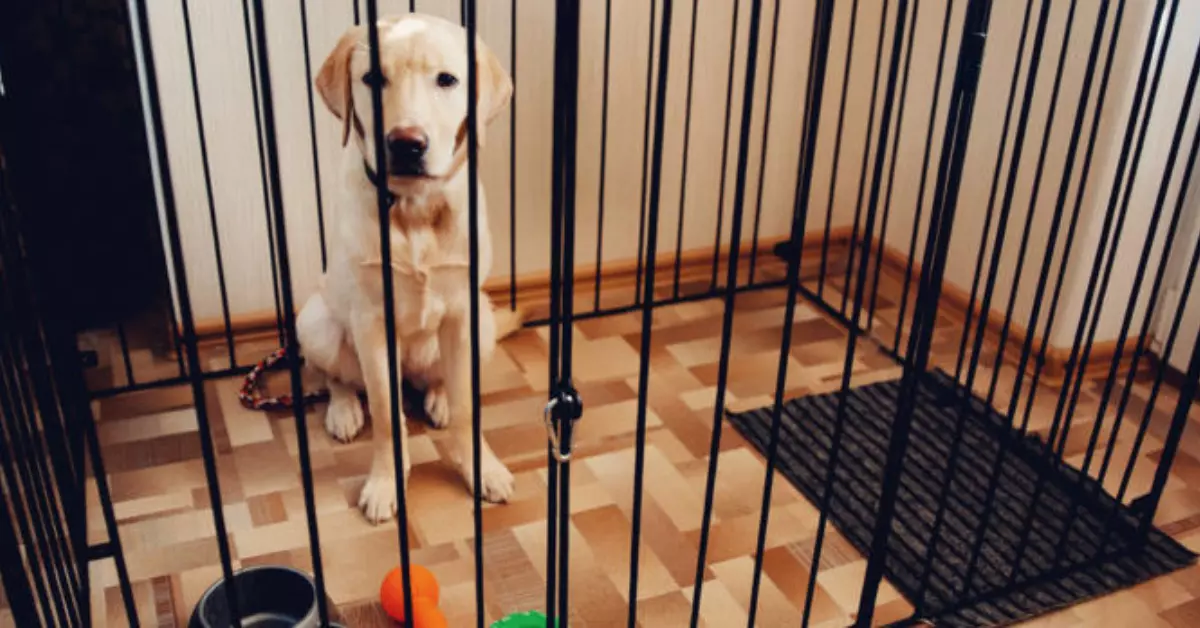
How to Properly Use a Crate and Cage
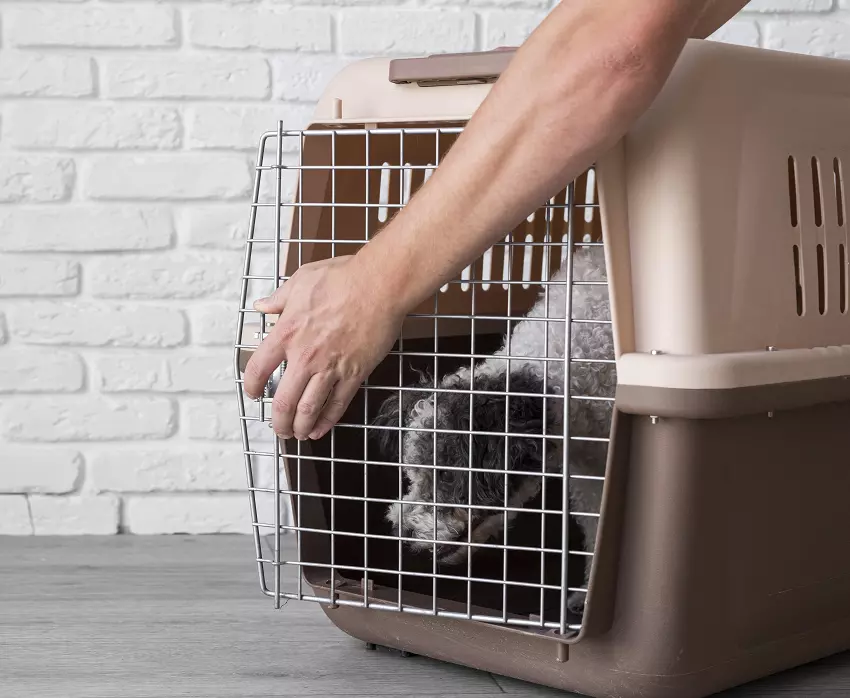
Many pet parents don’t like to crate-train their pets because they think that confinement is cruel. But when done properly, a crate can give dogs a sense of security, and it’s also an effective way to manage your pets when you’re not around.
One of the reasons many people are against crates and cages is that the method can easily be abused. If you plan on crate training your pets, be sure to set appropriate periods coupled with different goals, such as preventing destructive behavior, house training, and teaching your pet to settle.
If you teach your dog to love the crate rather than fear it, it becomes his safe place, like how children feel about their bedrooms. A crate or kennel is somewhere your dog can go if they want to be unbothered. It’s perfect for dogs that are tired or anxious. Since dogs have an instinct to be in a den, most of them can easily adjust to crates.
How Crate Training Helps Pet Parents
Crate training offers several benefits for pet parents as well. For example, if your pet has a perfectly sized crate, your dog will instinctively keep their space clean.
This helps them control their bladder and bowel.
Additionally, using a crate keeps your pet safe during times when you can’t supervise them directly, such as during night times, when you’re at work (given that your work hours isn’t too long and that your pets regularly gets exercise before and after crate time), when you have visitors, etc.
Another benefit of crate training is that it teaches excitable dogs and puppies to relax and enjoy some downtime in their safe space. To keep them secure and relaxed, place their favorite toys and cozy blankets inside.
Choosing a Crate for Your Pooch
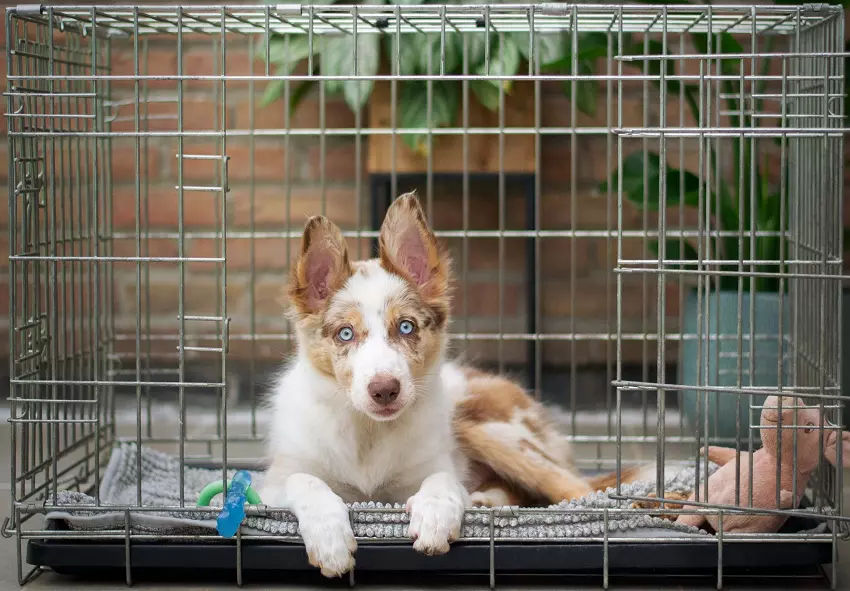
When choosing a dog crate, you need to consider several options, such as materials, size, and safety. With different types of crates available in the market, it can be overwhelming to choose the best one for your best friend.
Here are some of the factors you need to consider when choosing a crate:
Materials Used
Plastic dog crates are generally made from poly-blend materials with a steel bar door. These crates are leak-proof and have ventilated side panels. If you’re planning to travel with your pet, airlines usually approve plastic crates.
If you’re looking for security, portability, and ventilation, wire dog crates may be the best option for you. Many of these crates can fold down to a smaller size for better storage. In addition, it’s straightforward to clean because of its open space feature.
There are dog crates specifically made for travel. These crates are often more durable compared to the ones mentioned above. In addition, they offer hardwearing construction, excellent visibility, and maximum ventilation. It’s the perfect type of crate if you frequently fly or drive with your dog. Plus, you can use them for crate training as well, hitting two birds with one stone.
All of these crates offer universal features that you would expect from a dog crate. But some crates are made for specific needs and preferences. So be sure to observe your dog and figure out what they need when choosing a crate for them.
Size
Crates come in varying sizes, so you need to make sure that you get the right crate size for your dog. The last thing you want is to have your dog crouch inside a crate that’s too small for them.
The perfect size depends on the height and length of your pet. Their crate should have enough space for your dog to stand without ducking his head below his shoulders. They should also be able to lie down and stretch without any problems comfortably. Please read also my article about how to block off a large crate for a puppy.
If you’re buying a crate for a puppy, you can purchase one with divider panels so you can adjust the size as your pup grows. Another thing to keep in mind is that you shouldn’t buy a crate that’s too big either. Dogs have an instinct to keep themselves clean. But if the crate is too big for them, they might relieve themselves in one corner and sleep in another.
Safety
Aside from keeping your furniture safe from your excitable dog, crates can also keep your pet safe from dangerous situations if you aren’t there to look after him. Think of the crate as a child’s car seat. Your pet needs to be appropriately secured when going on long drives. When you place your dog in a crate, be sure to remove his leash so it won’t get stuck and choke your dog.
Is it Cruel to Keep a Dog in a Crate All Day?
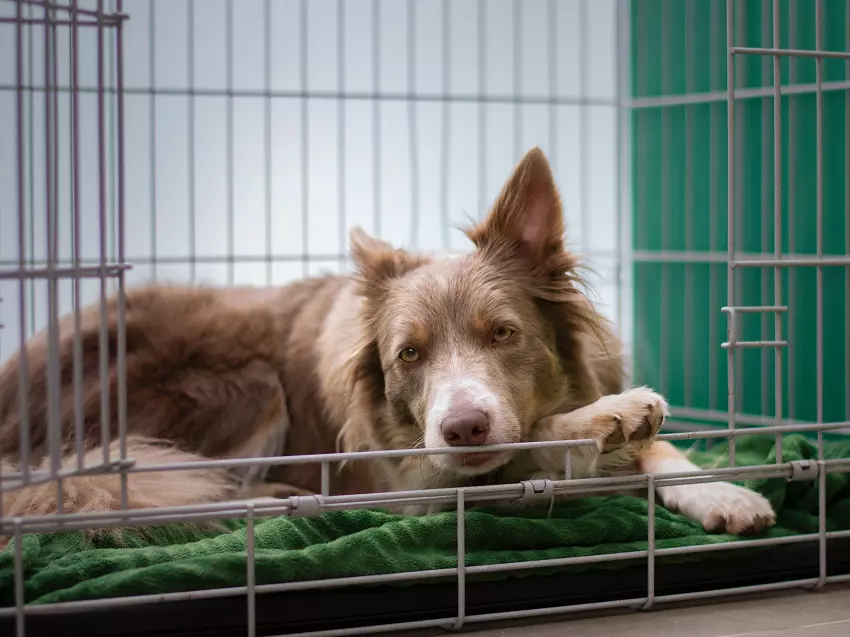
The answer depends on the pet owner’s intentions. It’s essential to answer the following questions when it comes to crate training:
- How do you train your dog to use a crate?
- Why do you want to crate train your dog?
- How long are you planning to keep them in the crate?
Many people argue that keeping a dog in a cage all day is inhumane and causes psychological damage. The crate itself doesn’t cause damage, but people can cause harm in the way they misuse the crate.
If you’re going to put your dog in a crate for more than 12 hours a day, five days a week, then this can cause psychological harm. However, the damage is not because of the crate, per se. Instead, the crate acts as a tool you’ve chosen to commit acts of cruelty. Please read my article on how to transport a dog in a truck bed.
A leash and a collar are only cruel if you tie your dog to a post most of the day or yank them by their necks. But with proper use of a leash and collar, it becomes a valuable tool that keeps you and your dog safe. Of course, no dog likes to be tied to a leash when you put it on for the first time. But pet owners take the time to train their pets until they learn to get used to it.
The same goes for dog crates. You need to train your dog to get used to staying in a crate. Teach them to see crates as a safe space rather than a prison. Like the leash, using crates properly and sparingly contributes to your furry friend’s safety and well-being.
Critics’ Take on Crates Causing Psychological Problems
As mentioned, the psychological problems “caused” by crates are a result of crate misuse. Some pet owners use crates as a punishment tool. When this happens, dogs will see crates as more of a prison rather than a home. Read also my article about why dogs won’t leave a crate.
Some people also use crates for long-term isolation with no interaction or physical activity. This causes obsessive habits (licking, chewing, etc.), separation anxiety, muscular atrophy, withdrawal, and difficulty bonding with other people.
To keep this from happening to your furry friend, make sure that your dog will only be created for a few hours a day. Crates come in handy during puppy management and training in the early stages of life. When your dog becomes an adult and has become adept at living with humans, he wouldn’t need the crate as often as he used to.
How Long You Should Leave Your Dog Alone
Compared to adult dogs, puppies find it harder to hold their bladders and bowels. For this reason, puppies should get minimal crate time than older dogs.
There are different opinions when it comes to crate training puppies. According to the Humane Society of the United States and the American Society for the Prevention of Cruelty to Animals (ASPCA) say that you shouldn’t leave puppies younger than six months in crates for more than three to four hours.
On the other hand, Modern Dog Magazine says that puppies can stay in their crates for hours based on their month of age plus one. For example, a six-month-old puppy can stay in its crate for seven hours.
However, the number of hours varies depending on your puppy’s behavior. It’s best to observe your puppy for the first few weeks to have an idea of their limit. If your puppies accidentally pee and empty their bowel, they have likely been left in the crate too long. Make sure to give them time to exercise and relieve themselves before and after putting them in the crate.
Crate Time for Adult Dogs
Adult dogs can stay in the crate longer than puppies do. You can leave them for about half a day, but your dog should get enough exercise when he’s out of the crate.
Many adult dogs can stay for as much as eight houses, but long hours in crates can affect your dog’s behavior. If you work long hours every day, you can consider getting a dog walker to leaving your pet in a doggy daycare to shorten crate time.
Risk of Overusing the Crate
Overusing the crate compromises the usefulness of training. For instance, if your dog relieves himself inside the crate, he may have more similar accidents in the future. This means that you can’t leave your pet anywhere safe without any issues. Please read my article puppy throwing tantrum in the crate.
If you leave your dog inside the crate for too long, they will likely grow to fear crates instead of training them to be more relaxed inside it. In worse cases, dogs left in the crate for hours on end may develop health problems, difficulty following commands, as well as aggression issues.
There’s a reason why dogs are called man’s best friend. They are social animals that love to interact with people and other dogs. Leaving them by themselves inside a crate causes them to get lonely.
This is especially true for puppies, so it’s even more important not to leave them at home all day. Puppies younger than 14 weeks need to socialize with other people. Well-socialized puppies are more likely to grow into safe and relaxed adult dogs.
Leaving Your Pet in the Crate While You Work
As mentioned, it’s not advisable to leave your pet locked in a crate while you’re at work for the day. However, this largely depends on your work schedule.
The longest you can leave an adult dog inside a crate is eight hours, and that’s including their overnight sleeping time. Your dog needs to be active during the daytime. If you have flexible work hours, you can regularly check on your dog and take him out for walks.
However, the number of hours you leave a dog in a crate depends on your pet and temperament. Be sure not to go over the maximum of two to four hours during the day. If you have a puppy and work long hours, you might want to look for other ways to keep them entertained.
How to Crate-Train Your Dog?
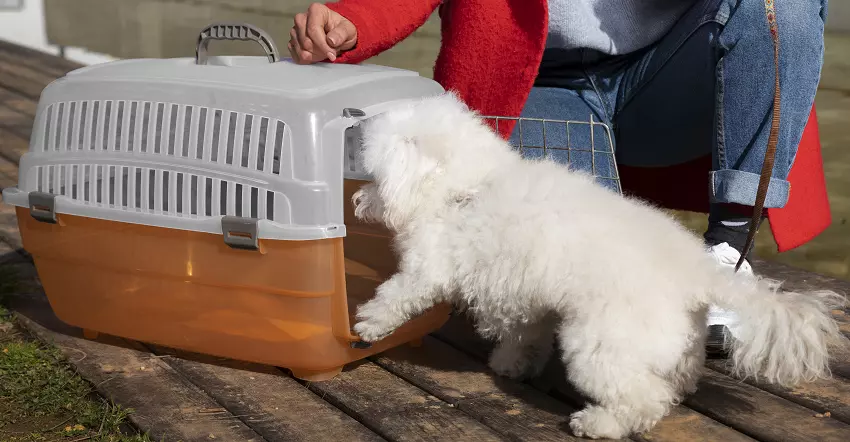
The duration of crate training depends on your dog’s age, previous experiences, and temperament. When training your dog, keep in mind that the crate should always be associated with something positive. Also, don’t rush; crate training usually takes time, so be sure to celebrate small victories.
Here are steps on how to effectively crate train your puppy:
STEP 1: Introduce your dog to his new crate
Ideally, your pet’s crate should be placed in an area where you spend a lot of time, like in the living room. Put a soft blanket in the crate and remove the door so your dog can check it out whenever he wants to.
Dogs are naturally curious. Some of them may even start sleeping in the crate right away. But, unfortunately, this isn’t the case for most dogs.
Here’s what you can do if your dog is hesitant to go near the crate:
- Bring your pet near the crate and talk to them in a cheerful voice. Keep the crate door open and secure.
- Encourage your dog to go inside the crate by putting small treats outside the crate, near the door, and inside the crate. If they don’t want to go in despite giving them treats, don’t force them. Again, take it slowly.
- Continue to toss treats until your dog walks to the back of the crate. This can take a few minutes or several days. You can also try to throw in their favorite toy.
STEP 2: Place your dog’s meals in the crate
The next step is to place your dog’s meals near the crate regularly. This is one of the ways to help your pet associate the crate with something pleasant.
- If your pet has no problem going inside, you can place their meals at the back of the crate.
- If they’re still hesitant, you can put the dish near the crate or inside it near the door, whichever is comfortable for your pet.
- Place the dish a little further into the crate every time you feed your pet.
- If your pet is comfortable enough to eat inside the crate, you can slowly close the door as they’re eating. Make sure to open the door right after they eat the first time you do this. Then, you can leave the door closed a few minutes longer after the first successful feeding. Do this until they can stay in the crate for about 10 minutes after eating.
- If your dog starts to whine, you may have increased the crate’s time too quickly. Try to leave them inside for a shorter period. However, don’t let them out while they’re whining. Wait until they stop; otherwise, they might learn that you’ll let them out every time they complain.
STEP 3: Keep your dog in the crate for short periods
Once your pet is accustomed to eating inside the crate without anxiety, you can confine them inside for short periods while you’re at home.
- Cheerfully call your pet over to the crate and give them a treat.
- Give them a command to go inside the crate, like “inside” or “go in”. And then point inside the crate with a treat in hand.
- Once your dog goes inside, compliment them, give them the treat, and then close the crate.
- Don’t leave your pet right away. Sit outside the crate for about five to seven minutes and then go to another room for another five minutes. Sit near the crate again for a few minutes before letting them out.
- Repeat the same process three to four times a day and gradually increase the length of time you leave inside and when you’re in another room.
- If your dog is comfortable enough to say inside the crate for half an hour without you near, you can start leaving them inside or sleeping at night. This process may take a few days or weeks.
STEP 4: Put your dog in the crate when you leave the house
Once your pet has no problem spending 30 minutes in the crate, the next step is to leave them inside for short periods while you leave the house.
- Using the command you’ve given them along with a treat, ask your dog to come in the crate. To give them a sense of security, you can leave a cozy blanket and a few of their toys inside.
- Crate your dog when you’re getting ready to leave, but make sure to switch it up. For example, today, you’re crating your dog five minutes before you go. The next day, put them in the crate 15 minutes before you leave. You can start crating your dog anywhere between five to 20 minutes before leaving.
- Don’t be emotional when you leave. Once your dog enters the crate, praise them briefly, give them their treat, and then leave.
Your dog will naturally be excited when you return home. However, refrain from responding to them enthusiastically. Instead, when you arrive home, be casual about avoiding getting your pet anxious when you’ll return.
To prevent your pet from associating crating with you leaving, continue to put them inside the crate for short periods when you’re home.
STEP 5: Crate your dog during the nighttime
Before going to bed, put your dog inside the crate with your command and treat. You can put the crate in your bedroom or in the hallway to keep your pet more comfortable, especially if they’re still puppies. Puppies often need to go outside to relieve themselves during nighttime, so you want to be near enough to hear them whine. Adult dogs should also be kept nearby in the first few days to avoid associating crates with isolation. You can gradually move the crate to the location you want once your pet can comfortably sleep through the night.
Potential Problems When Crate Training
While crate training, here are two of the most common problems pet owners face:
Whining
There can be two reasons why your dog whines in the crate at night: they want to go out of the crate, or they need to pee or poo. If you diligently followed the training procedures, your dog knows that whining doesn’t release them from the crate. If your dog is just testing you, they will most likely stop in a few minutes. Don’t yell at them or pound their crate. Otherwise, they’ll become more and more anxious.
If the whining persists even after a few minutes, ask your dog if they want to go outside to pee. You can take them outside if they respond with excitement. However, this trip isn’t playtime, so go out and come right back in afterward.
If you think that your dog doesn’t need to eliminate waste, you can ignore them until they stop whining. Giving in will only teach them to complain some more to get what they want. If you took your time and gradually progressed through the training steps, there’s a tiny chance that your dog will whine at night. If the whining becomes uncontrollable, you might need to go through the crate training process again.
Separation Anxiety
You shouldn’t place a dog with separation anxiety inside a crate. This will only worsen the situation. You can only resolve separation anxiety through desensitization procedures. Soiling the house, excessive drooling, scratching doors and windows, trying to escape, nonstop barking and whining, and destructive chewing are some of the signs that your dog suffers from separation anxiety. If your dog exhibits any of these symptoms, seek professional help as soon as possible.
How to Create a Comfortable Crate for Your Pet
Your dog should think of their crate as their safe space. An area to relax after a walk in the park or a place where they sleep and eat. Your pet’s crate should be filled with all of their favorite things, and you need to add more as you train them to sleep in it. Add their favorite pillows and blankets, their toys, along with a timed feeder and a water bowl. You can even transform the crate to look like a little house. Once they’re completely comfortable, place the crate in your house’s quietest place, like your bedroom.
What NOT to Put Inside the Crate
If you’re planning to decorate your dog’s crate, here are some of the things you need to avoid:
- They are placing the crate near plants poisonous to dogs. Crates in the living room are generally not a nice thing to look at. Pet owners try to beautify the area by placing potted plants nearby. This wouldn’t be a problem if the plants you put weren’t poisonous to dogs. To make sure, you can visit ASPCA Animal Poison Control to see the list of toxic plants.
- You are placing the crate near hot and cold areas. To keep your pet comfortable and safe, be sure to place them away from hot and cold areas, such as baseboards, fireplaces, etc.
- You are bringing collars and tags inside the cage. Remove your pet’s collars and tags before you let them inside the crate. This is because dangling dog tags can get caught in the wires, causing your pet to choke.
- They are placing the crate near electric and power cords. Playful dogs may sometimes pull nearby electric cords into their crate and chew on them. Be sure to place the crate away from these hazards to avoid harm.
Other Ways to Keep Your Dog Entertained While You’re at Work
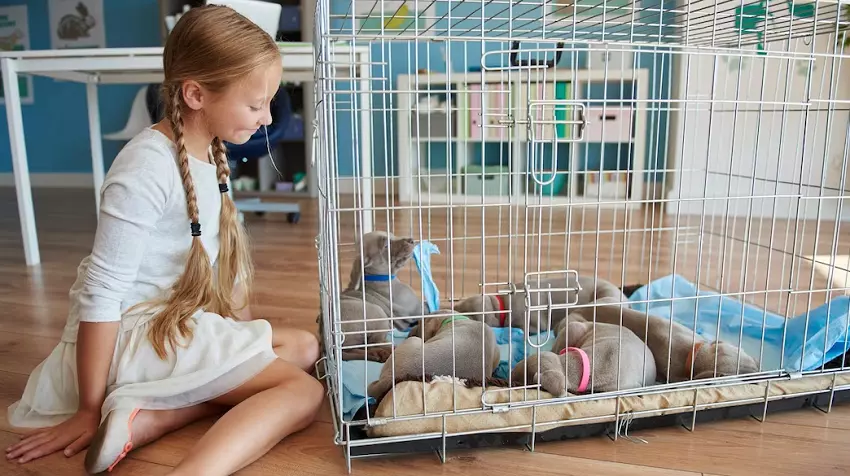
If you want to minimize crate time, here are a few ways you can keep your dog entertained while you’re at work:
Try Coming Home for Lunch
If you can, come home for lunch for at least two to three times a week. If there are several people in the household, you can take turns to visit your pet during lunch break to let them out.
Use a Dog-Walking Service
Did you know that you could hire someone to walk your dog? It’s a good idea to hire a dog walker on days when you’re unable to come home.
Professional dog walkers offer several services, including a quick home visit, a walk in the neighborhood, or even training your dog in your home while you’re out. The drawback is that there are a lot of horrible dog-walking services in the market. Be sure to do your research and ask for referrals from family and friends.
Another option would be to hire someone you trust to come to your house to walk and play with your dog.
Enroll Your Pet in Doggie Daycare
Doggie daycares can be expensive. But if you have the cash to spare, you can enroll your dog even just for one to two days a week. However, not every dog likes daycare. But if your pooch enjoys other dogs’ company, enrolling them in daycare is a great way to meet your pet’s social and physical needs.
Just like dog walkers, no two doggie daycares are the same. Do your research, ask for referrals, and pick the daycares that are clean and staffed with professionals. It’s important to know that doggie daycare is mostly for adult dogs and not for puppies.
Bring Your Dog to Work Day
Not everyone can bring his or her pets to work, but if you can, then bring Fido with you! If your pet has separation anxiety, you can always ask a superior if you can bring your pet to the office. Even though it may seem highly unlikely, some companies allow employees to bring their pets if they ask.
Ask Someone to Visit Your Dog
You can ask your neighbor, your friends, or a kid who needs a summer job. Ask them to go to your house at least once a day to let your dog out. Your pet will surely love a midday visit from his friend.
Final Thoughts
To crate or not to crate? You decide to make.
Observe your furry friend. If your dog enjoys spending time in their crate, you may leave their crate open to them for most of the day. However, be sure to give them access to other parts of your home, such as the yard, so they can come and go whenever they like.
If you think your dog has destructive behaviors or if he is a danger to himself, you can limit your pet’s access to certain parts of your home.
On the other hand, if you’ve decided that keeping a dog in a cage all day is not a viable solution, there are other solutions to keep them entertained while you’re away. For example, you might want to consider a doggy daycare or pet-sitting services.
